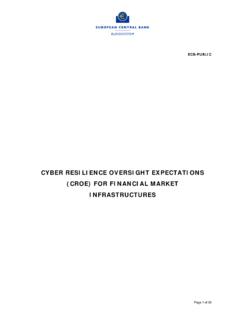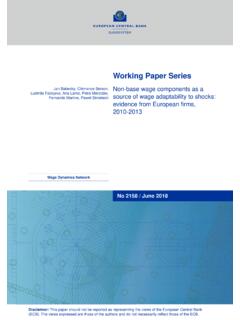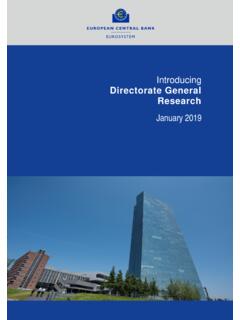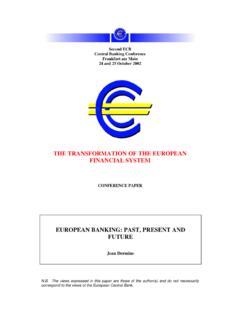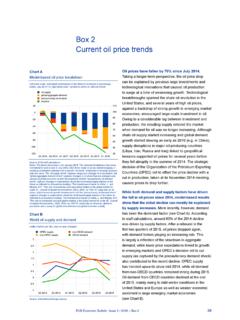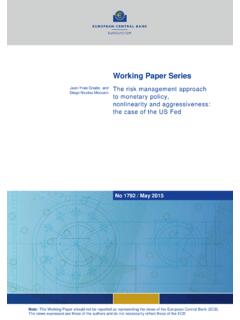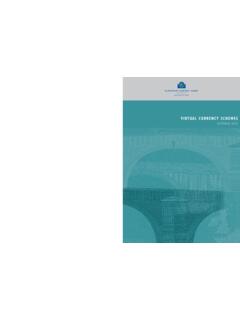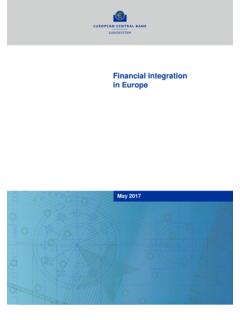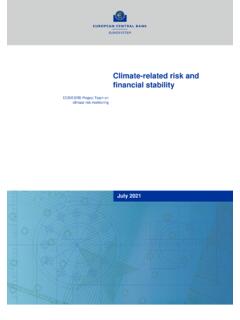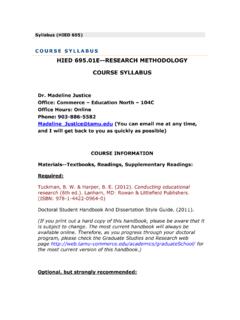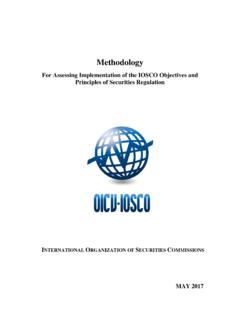Transcription of The euro short-term rate (€STR) methodology and policies
1 The euro short-term rate ( STR) methodology and policies , March 2021 1 The euro short-term rate ( STR) methodology and policies March 2021 1 Background In September 2017 the ECB announced that its Governing Council had decided to develop a euro unsecured overnight interest rate on the basis of data already available to the Eurosystem. The euro short-term rate ( STR) will complement existing benchmark rates produced by the private sector and will serve as a backstop reference rate. In the design process the ECB considered the feedback of the public via two public consultations. In addition, the ECB aims to ensure that the design and implementation of the new unsecured overnight rate is consistent with international best practice set out in the IOSCO Principles for Financial benchmarks1. This document provides details on how the euro short-term rate ( STR) is calculated and managed. 2 STR administrator The ECB is the administrator2 of the euro short-term rate ( STR) and has overall responsibility for providing the rate.
2 3 Definition of the euro short-term rate ( STR) Statement of underlying interest The euro short-term rate ( STR) is a rate which reflects the wholesale euro unsecured overnight borrowing costs of euro area banks. The rate is published for each TARGET2 business day based on transactions conducted and settled on the previous day (reporting date T) with a maturity date of T+1 and which are deemed to be executed at arm s length and thereby reflect market rates in an unbiased way. 1 See OICV-IOSCO Principles for Financial Benchmarks, Final Report of July 2013. 2 See definition in Annex A (Glossary of Key Terms) of the above IOSCO Final Report. The euro short-term rate ( STR) methodology and policies , March 2021 2 Statement of methodology The euro short-term rate ( STR) is exclusively based on borrowing transactions in euro conducted with financial counterparties that banks report in accordance with Regulation (EU) No 1333/2014 (MMSR Regulation)3, the concepts and definitions of which underlie the STR conceptual framework.
3 Out of the potential MMSR instrument categories, the euro short-term rate ( STR) is calculated using overnight unsecured fixed rate deposit transactions over 1 million. Unsecured deposits are standardised and are the most frequent means of conducting arm s length transactions on the basis of a competitive procedure, thereby limiting idiosyncratic factors potentially influencing the volatility of the rate. The euro short-term rate ( STR) is calculated for each TARGET2 day as a volume-weighted trimmed mean rounded to the third decimal. The volume-weighted trimmed mean is calculated by: transactions from the lowest rate to the highest rate; the transactions occurring at each rate level; the top and bottom 25% in volume terms; the mean of the remaining 50% of the volume-weighted distributionof pro rata calculation is applied to volumes that span the thresholds for trimming to ensure that exactly 50% of the total eligible volume is used in the calculation of the volume-weighted mean.
4 4 Data The euro short-term rate ( STR) is based on daily confidential statistical information relating to money market transactions collected in accordance with the MMSR Regulation, which entered into force on 1 January 2015. The regular data collection started on 1 July 2016. The euro short-term rate ( STR) is based exclusively on the eligible data from the unsecured market segment of the MMSR. The reporting requirements for the MMSR as well as the current reporting population are available on the ECB website. The data quality management process includes a set of technical checks which verify that the submitted data complies with the structure and formats required for the MMSR. Furthermore, a large number of data quality checks are carried out to ensure the correctness of the reported data. In addition, a set of targeted data quality checks 3 See Regulation (EU) No 1333/2014 of the European Central Bank of 26 November 2014 concerning statistics on the money markets (ECB/2014/48).
5 The euro short-term rate ( STR) methodology and policies , March 2021 3 are carried out to decide which transactions, if any, should be excluded from the calculation of the STR. The data quality management process is complemented by the statistical non-compliance procedure, which provides for the monitoring and enforcement of reporting agents compliance with the minimum standards. These minimum standards are defined in the MMSR Regulation and include minimum standards for transmission, accuracy, compliance with concepts and revisions. The minimum standards for transmission include, among others that the reporting must be timely and the statistical reports must take their form and format from the technical requirements set by the ECB and the relevant national central bank (NCB). The minimum standards for accuracy set a number of rules to ensure that the reported information is correct and complete, while the minimum standards for conceptual compliance relate to compliance with the definitions and classifications contained in the MMSR Regulation.
6 Compliance with the minimum standards is regularly monitored by the ECB and NCBs. In the case of non-compliance, the respective reporting agents are contacted and asked to implement corrective measures. In case of repeated non-compliance, an infringement procedure is initiated and sanctions may be imposed in accordance with the applicable legal framework. 5 Publication Standard daily publication arrangements The ECB publishes the euro short-term rate with three decimal places4 no later than 09:00 CET on the next TARGET2 business day. Together with the STR, the following related information is published: total nominal value of transactions before trimming in EUR millions; number of banks reporting transactions before trimming; number of transactions before trimming; percentage of total nominal amount reported by the five largest contributingbanks that day, as a whole number; calculation method: normal or contingency; rates at the 25th and 75th percentiles with two decimal Using standard rounding, rounded to the nearest third decimal (below is rounded down, above and equal to is rounded up).
7 The euro short-term rate ( STR) methodology and policies , March 2021 4 Compounded STR average rates and index The ECB calculates and publishes daily compounded STR average rates and a compounded index using only historical daily values of the 6 Contingency arrangements Data sufficiency triggering contingency procedure A short-term contingency procedure will be triggered where: the number of reporting banks is less than 20; or five banks account for 75% or more of total transaction two criteria are intended to address, among others, cases where (i) there is a genuine lack of data or (ii) systems break down, preventing a sufficient data feed, thereby impairing the calculation of a representative transaction-based rate. Contingency computation methodology If one of the criteria triggering the contingency procedure is met, the STR will be calculated by combining the rate from the previous TARGET2 business day with the rate that would result from applying the standard methodology to the available trades on the day in question, as well as any change in the ECB s key interest rates if the contingency procedure is activated on a day when a change in these rates occurs.
8 The rate is calculated using the standard methodology base on the (insufficient)daily transactions. Then a volume-weighted average is calculated using theresulting rate and that of the day before. The volume weighting implies that incase of a total absence of reported transactions on the publication day, the rateof the prior TARGET2 business day is used. If there is a change in the ECB s key interest rates effective on the sameTARGET2 business day for which the STR is being calculated, the rate fromthe previous TARGET2 business day is adjusted to reflect this in accordancewith the following rules: if the ESTR is outside the ECB s key interest rate corridor ( below thedeposit facility rate or above the marginal lending facility rate), then theadjustment to the previous day s STR will be equal to the change in thedeposit facility rate or the marginal lending facility rate, respectively;5 Publication started on 15 April 2021. See Compounded STR average rates and index calculation and publication rules, March 2021.
9 The euro short-term rate ( STR) methodology and policies , March 2021 5 if the rate from the previous day is within the ECB s key interest rate corridor and the change in the key rates does not result in a change in the width of the corridor ( all rates are changed by the same amount), then the previous day s STR will be adjusted by the same amount as the change in the ECB s key interest rates; if the STR is within the ECB s key interest rate corridor and a change in the key rates changes the width of the corridor, then the previous day s rate is adjusted so that the position of the previous day s rate within the new corridor remains unchanged. It is possible to repeat the contingency procedure for several days in a row. If the ECB does not publish the STR by 09:00 CET, the rate of the previous TARGET2 business day applies (modified as described above if a change in policy rates occurred on that day). 7 policies for handling data errors Section 4 outlines the process that ensures the quality of the data used to calculate the STR and allows for timely publication.
10 However, given that limited errors could still potentially occur, this section sets out how such errors would be handled, including in which circumstances the benchmark would be republished. Republication policy If errors are detected following standard publication that affect the published STR by more than 2 basis points, the STR is revised and republished on the same day, no later than 11:00 CET. Transparency policy In order to support the transparency of the benchmark determination process, the ECB will periodically publish summary information on errors larger than basis points that were detected after the standard publication and did not meet the republication criteria. 8 Review of methodology The methodology and policies will be reviewed regularly to ensure that the underlying interest is adequately measured and captured by the methodology and that the procedures and policies are effective. The euro short-term rate ( STR) methodology and policies , March 2021 6 9 Access and usage The use of the euro short-term rate ( STR) is free of charge and not subject to a licence agreement.
